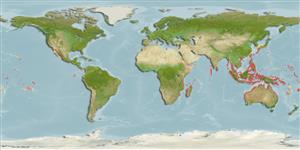Common names from other countries
Environment: milieu / climate zone / depth range / distribution range
Sinh thái học
Biển; Nước ngọt; Thuộc về nước lợ Cùng sống ở rạn san hô; sống cả ở nước ngọt và nuớc mặn (Ref. 46888); Mức độ sâu 0 - 1 m (Ref. 86942). Tropical
Indo-Pacific: along East African coast, from Zululand in South Africa northwards to the Red Sea and most of West Indian Ocean islands (Ref. 4756); further east to the Marianas and Samoa; north to Ryukyu Islands, south to western Australia and Oceania (Ref. 2334).
Length at first maturity / Bộ gần gũi / Khối lượng (Trọng lượng) / Age
Maturity: Lm 5.0 range ? - ? cm
Max length : 19.0 cm TL con đực/không giới tính; (Ref. 4756)
Các tia vây lưng cứng (tổng cộng) : 12 - 18; Các vây lưng mềm (tổng cộng) : 9 - 12; Tia cứng vây hậu môn: 1; Tia mềm vây hậu môn: 8 - 11. Diagnosis: Distinguished by the following characteristics: pelvic fins lacking frenum; little or no membrane uniting medial most pelvic rays; first dorsal fin height moderate, its margin usually convex, occasionally straight, with a black stripe inframarginally and numerous small, white spots posteriorly on fin, no elongate spines; second dorsal fin with single, dusky stripe mesially; dorsal fins not connected by membrane; first dorsal fin with 11-16 spines; longitudinal scale count 64-100; head width 14.3-22.6% of standard length; pelvic fin length 11.3-15.2% of standard length; length of anal fin base 14.0-19.4% of standard length; length of second dorsal-fin base 17.6-23.7% of standard length; total D2 elements 10-13; total anal fin elements 9-12; TRDB 18-26 (Ref. 5218).
Facultative air-breathing (Ref. 126274); A resident intertidal species with homing behavior (Ref. 32612, 48637) and amphibious air-breather (Ref. 31184, 79840), found in brackish mud flats in mangrove and nipa palm areas. Found in both littoral and estuarine; able to climb out of water, in mangrove swamps and burrowing into intertidal mud banks (Ref. 4756). Occasionally in the lower parts of freshwater streams (Ref. 2847, 44894, 48637, 79840). Actively shuttling back and forth between rock pools and air (Ref. 31184). It feeds on worms, crustaceans, and insects (Ref. 37816). Can stay out of the water for up to 37 h if kept moist (Ref. 51276).
Life cycle and mating behavior
Maturities | Sự tái sinh sản | Spawnings | Egg(s) | Fecundities | Ấu trùng
Murdy, E.O., 1989. A taxonomic revision and cladistic analysis of the oxudercine gobies (Gobiidae: Oxudercinae). Rec. Aust. Mus., Suppl. 11:1-93. (Ref. 5218)
IUCN Red List Status (Ref. 130435)
CITES (Ref. 128078)
Not Evaluated
Threat to humans
Harmless
Human uses
Các nghề cá: không ích lợi (thú vị); Bể nuôi cá: Tính thương mại
Các công cụ
Special reports
Download XML
Các nguồn internet
Estimates based on models
Preferred temperature (Ref.
115969): 24.2 - 29.3, mean 28.4 (based on 2897 cells).
Phylogenetic diversity index (Ref.
82804): PD
50 = 0.5000 [Uniqueness, from 0.5 = low to 2.0 = high].
Bayesian length-weight: a=0.01072 (0.00495 - 0.02318), b=2.97 (2.79 - 3.15), in cm Total Length, based on LWR estimates for this Genus-body shape (Ref.
93245).
Mức dinh dưỡng (Ref.
69278): 3.3 ±0.40 se; based on food items.
Thích nghi nhanh (Ref.
120179): Chiêù cao, thời gian nhân đôi của chủng quần tối thiểu là dưới 15 tháng (Preliminary K or Fecundity.).
Fishing Vulnerability (Ref.
59153): Low vulnerability (10 of 100).
